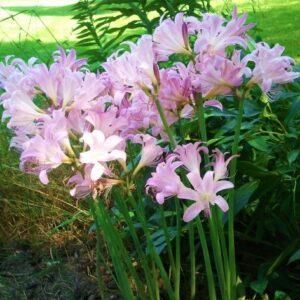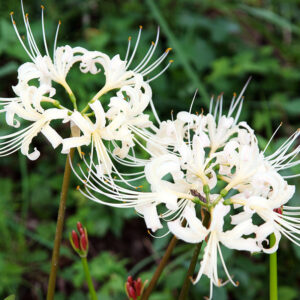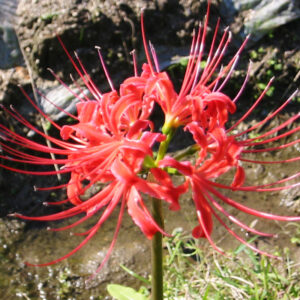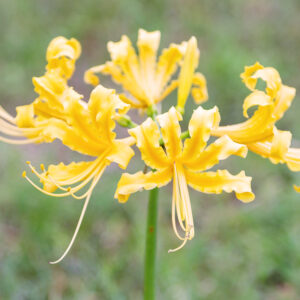
Lycoris bulbs go by many names. Gardeners in different parts of the country call these summer-blooming bulbs a host of different common names. Spider Lily, Surprise Lily, Disappearing Lilies, and Magic Lilies are some of the names. Some regions of the United States even call these mysterious summer bulbs naked lady bulbs. But what makes them so elusive that they have garnered all sorts of curious names? Leaves appear in spring and then disappear for summer. In late summer tall flower stalks of lily-like blooms appear, like magic out of seemingly nowhere. After the flowers appear leaves form again in fall. This magic trick these bulbs perform has helped lyrcois to earn a myriad of names. To learn more about these magical summer beauties read our complete guide to growing lycoris.
Growing Lycoris
Who Should Plant Lycoris
Gardeners who want a burst of colorful blooms in late summer should plant lycoris. Lycoris look nice planted among low-growing perennials and ground cover. They have tall skinny stems with showy flowers that appear above the low-growing perennials.
When to Plant Lycoris
Lycoris bulbs are available for planting in early fall. Planting lycoris in September or October is the ideal time.
Where to Plant Lycoris
Plant lycoris in a location that receives full sun for at least 6-8 hours per day. Lycoris require soil that drains well and is not overly moist in summer. There are several species of lycoris, some species are more tolerant of cold climates more than others. However, most lycoris are considered tender bulbs and grow best in hardiness zones 7 through 10.
Pink Magic Lily (Lycoris squamigera) are the most tolerant of cold climates, they can be grown in hardiness zones 5-9.
How to Plant Lycoris Bulbs
Lycoris is a true bulb with a definite top point. The pointed end of the bulb should face up. Plant lycoris 4-6″ deep in soil that drains well.
What are the Different Types of Lycoris Bulbs
Red Spider Lily (Lycoris radiata), White Spider Lily (Lycoris albiflora), and Golden Spider Lily (Lycoris aurea) are similar in growing requirements and appearance. These varieties of lycoris grow best in warm climates, such as hardiness zones 7-10. They have strap-like flowers that appear late in summer into early fall. Another name for these types of lycoris is Hurricane Lilies. They tend to start blooming when the hurricane season begins in parts of the southeastern United States.
Pink Magic Lilies are tolerant of colder climates and will grow in the midwest and northeastern hardiness zones. They will bloom in late summer, usually around the end of August. Their flowers are lily-shaped with wider petals than the red, white, or golden spider lilies.
What to plant with Lycoris?
While these magical bulbs stand out on their own having other plants surrounding them is best. Since they disappear of blooming having other perennials and annuals to fill the space is ideal. Daylilies, tall phlox, coneflower, black-eyed Susan, and veronica are perennials that look nice when planted with lycoris. Your favorite annual plants near the base of lycoris help to cover the tall stems.
Lycoris the Magical Disappearing Surprise Lily
Whatever name you call these unique novelty bulbs is up to you. They certainly are magical with their unique spider-like blooms. Yes, they may appear early in spring only to disappear for summer and then return again late summer, but that is the surprise of lycoris. Lycoris is also known to attract butterflies and hummingbirds. If you like pollinators in the garden lycoris are a lovely addition to the late summer pollinator garden.





